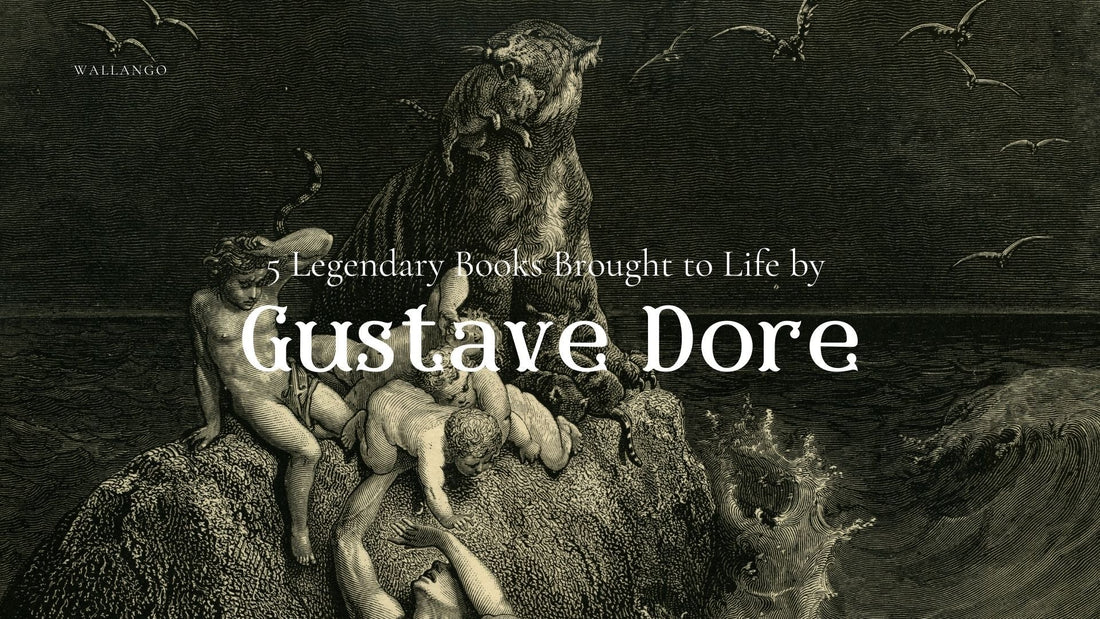
5 Legendary Books Brought to Life by Gustave Dore
Share
Gustave Doré and the Art of Illustrated Books
Adam and Eve Driven Out of Eden (Genesis 3:24)
In 1855, at just twenty-three years old, Gustave Doré aspired to illustrate literary masterpieces in the form of lavish folio editions. Dante would be the first on this ambitious list. Unable to find a publisher willing to take a risk on such a costly endeavor led by a young artist, Doré decided to finance the publication of Inferno himself. His gamble paid off—the book, published in 1861 by Hachette, was a resounding success, allowing him to begin realizing his youthful dream.
The edition featured seventy-five full-page illustrations, engraved on wood by various artisans, transforming the text into a series of striking black-and-white tableaux. Doré’s marketing strategy, which involved exhibiting a selection of preparatory drawings in several Parisian venues, created anticipation among the public. Demand was so high that the entire print run of three thousand copies quickly sold out.
Few illustrators had dared to tackle Dante’s work before Doré, whose fascination with the text dated back to 1855. Inferno became a revelation of his visionary and fantastical imagination. As Théophile Gautier famously remarked, Doré “invented the climate of Hell.”

“Then my terror redoubled at the sight of the abyss” Song XVII, verse 121
In 1855, Gustave Doré included Don Quixote by Cervantes on his ideal list of literary masterpieces to illustrate as lavish folio editions. The two volumes, published by Hachette in 1863, featured 377 drawings, including 120 full-page illustrations, all engraved on wood by Héliodore Pisan—a testament to the illustrator’s trust in his engraver. The result of this remarkable collaboration was nothing short of extraordinary. Despite its high cost, the book was a great success.
In 1869, a new popular edition released in 80 installments made Doré’s illustrations accessible to a wider audience. Before him, several artists had already taken on the challenge of illustrating Cervantes' work, notably Tony Johannot, Grandville, and Daumier, whose paintings depicted the novel’s themes.
Doré’s 1862 journey to Spain with his friend Charles Davillier, a connoisseur of the country, along with his work sessions with Louis Viardot, the translator of Cervantes’ text, played a crucial role in shaping his vision. However, more than anything, it was his love for fantasy and the grotesque that made his depiction of Don Quixote and Sancho Panza one of his greatest masterpieces.

"His imagination filled up with everything he had read". Volume 1, Chapter 1
Orlando Furioso (translated as The Frenzy of Orlando) is a monumental epic poem by the Italian Renaissance writer Ludovico Ariosto, first published in 1516 and expanded in later editions. A continuation of Matteo Maria Boiardo’s Orlando Innamorato, this masterpiece blends chivalric romance, adventure, and mythology with rich satire and psychological depth.
The poem follows the knight Orlando, a valiant paladin of Charlemagne, who descends into madness after being consumed by his unrequited love for the beautiful Angelica. Alongside Orlando’s tragic passion, Ariosto weaves a vast tapestry of intertwining stories, including the heroic exploits of Ruggiero and Bradamante, the conflicts between Christians and Saracens, and magical elements such as enchanted castles and mystical creatures.
Renowned for its imaginative storytelling, intricate structure, and elegant verse, Orlando Furioso influenced generations of writers, from Shakespeare and Spenser to Cervantes and Voltaire. It remains one of the most celebrated works of Italian literature, admired for its wit, fantasy, and profound reflections on love, honor, and destiny.

Roger and the hippogriff, illustration by Gustave Dore
Gustave Dore prints by Wallango :
Why Choose our Prints?
Shop High-Quality Gustave Doré Prints
- Premium archival-quality print on thick, matte paper
- Faithful reproduction with sharp details and deep contrasts
- Available in multiple sizes to fit your space
- Perfect for home decor, office spaces, and libraries

